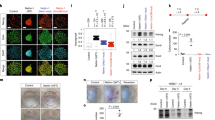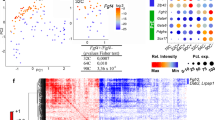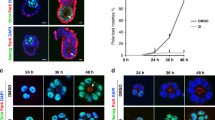Abstract
Canonical Wnt signalling has been implicated in mouse and human embryonic stem cell (ESC) maintenance; however, its requirement is controversial. β-catenin is the key component in this highly conserved Wnt pathway, acting as a transcriptional transactivator. However, β-catenin has additional roles at the plasma membrane regulating cell–cell adhesion, complicating the analyses of cells/tissues lacking β-catenin. We report here the generation of a Ctnnb1 (β-catenin)-deficient mouse ESC (mESC) line and show that self-renewal is maintained in the absence of β-catenin. Cell adhesion is partially rescued by plakoglobin upregulation, but fails to be maintained during differentiation. When differentiated as aggregates, wild-type mESCs form descendants of all three germ layers, whereas mesendodermal germ layer formation and neuronal differentiation are defective in Ctnnb1-deficient mESCs. A Tcf/Lef-signalling-defective β-catenin variant, which re-establishes cadherin-mediated cell adhesion, rescues definitive endoderm and neuroepithelial formation, indicating that the β-catenin cell-adhesion function is more important than its signalling function for these processes.
This is a preview of subscription content, access via your institution
Access options
Subscribe to this journal
Receive 12 print issues and online access
$209.00 per year
only $17.42 per issue
Buy this article
- Purchase on Springer Link
- Instant access to full article PDF
Prices may be subject to local taxes which are calculated during checkout







Similar content being viewed by others

References
Murry, C. E. & Keller, G. Differentiation of embryonic stem cells to clinically relevant populations: lessons from embryonic development. Cell 132, 661–680 (2008).
Doetschman, T. C., Eistetter, H., Katz, M., Schmidt, W. & Kemler, R. The in vitro development of blastocyst-derived embryonic stem cell lines: formation of visceral yolk sac, blood islands and myocardium. J. Embryol. Exp. Morphol. 87, 27–45 (1985).
Burkert, U., von Ruden, T. & Wagner, E. F. Early fetal hematopoietic development from in vitro differentiated embryonic stem cells. New Biol. 3, 698–708 (1991).
Smith, A. G. et al. Inhibition of pluripotential embryonic stem cell differentiation by purified polypeptides. Nature 336, 688–690 (1988).
Williams, R. L. et al. Myeloid leukaemia inhibitory factor maintains the developmental potential of embryonic stem cells. Nature 336, 684–687 (1988).
Ying, Q. L., Nichols, J., Chambers, I. & Smith, A. BMP induction of Id proteins suppresses differentiation and sustains embryonic stem cell self-renewal in collaboration with STAT3. Cell 115, 281–292 (2003).
Sato, N., Meijer, L., Skaltsounis, L., Greengard, P. & Brivanlou, A. H. Maintenance of pluripotency in human and mouse embryonic stem cells through activation of Wnt signaling by a pharmacological GSK-3-specific inhibitor. Nat. Med. 10, 55–63 (2004).
Xu, R. H. et al. Basic FGF and suppression of BMP signaling sustain undifferentiated proliferation of human ES cells. Nat. Methods 2, 185–190 (2005).
Daheron, L. et al. LIF/STAT3 signaling fails to maintain self-renewal of human embryonic stem cells. Stem Cells 22, 770–778 (2004).
Reubinoff, B. E., Pera, M. F., Fong, C. Y., Trounson, A. & Bongso, A. Embryonic stem cell lines from human blastocysts: somatic differentiation in vitro. Nat. Biotechnol. 18, 399–404 (2000).
Thomson, J. A. et al. Embryonic stem cell lines derived from human blastocysts. Science 282, 1145–1147 (1998).
Umehara, H. et al. Efficient derivation of embryonic stem cells by inhibition of glycogen synthase kinase-3. Stem Cells 25, 2705–2711 (2007).
Mao, J. et al. Low-density lipoprotein receptor-related protein-5 binds to Axin and regulates the canonical Wnt signaling pathway. Mol. Cell 7, 801–809 (2001).
Logan, C. Y. & Nusse, R. The Wnt signaling pathway in development and disease. Annu. Rev. Cell Dev. Biol. 20, 781–810 (2004).
Anton, R., Kestler, H. A. & Kuhl, M. β-catenin signaling contributes to stemness and regulates early differentiation in murine embryonic stem cells. FEBS Lett. 581, 5247–5254 (2007).
Ying, Q. L. et al. The ground state of embryonic stem cell self-renewal. Nature 453, 519–523 (2008).
Soncin, F. et al. Abrogation of E-cadherin-mediated cell–cell contact in mouse embryonic stem cells results in reversible LIF-independent self-renewal. Stem Cells 27, 2069–2080 (2009).
Wagner, R. T., Xu, X., Yi, F., Merrill, B. J. & Cooney, A. J. Canonical Wnt/β-catenin regulation of liver receptor homolog-1 mediates pluripotency gene expression. Stem Cells 28, 1794–1804 (2010).
Huelsken, J. et al. Requirement for β-catenin in anterior–posterior axis formation in mice. J. Cell Biol. 148, 567–578 (2000).
Kemler, R. From cadherins to catenins: cytoplasmic protein interactions and regulation of cell adhesion. Trends Genet. 9, 317–321 (1993).
Buxton, R. S. & Magee, A. I. Structure and interactions of desmosomal and other cadherins. Semin. Cell Biol. 3, 157–167 (1992).
Fukunaga, Y. et al. Defining the roles of β-catenin and plakoglobin in cell–cell adhesion: isolation of β-catenin/plakoglobin-deficient F9 cells. Cell Struct. Funct. 30, 25–34 (2005).
Zhou, J. et al. Upregulation of γ-catenin compensates for the loss of β-catenin in adult cardiomyocytes. Am. J. Physiol. Heart Circ. Physiol. 292, H270–H276 (2007).
Huelsken, J., Vogel, R., Erdmann, B., Cotsarelis, G. & Birchmeier, W. β-Catenin controls hair follicle morphogenesis and stem cell differentiation in the skin. Cell 105, 533–545 (2001).
Williams, B. O., Barish, G. D., Klymkowsky, M. W. & Varmus, H. E. A comparative evaluation of β-catenin and plakoglobin signaling activity. Oncogene 19, 5720–5728 (2000).
Conacci-Sorrell, M. E. et al. Nr-CAM is a target gene of the β-catenin/LEF-1 pathway in melanoma and colon cancer and its expression enhances motility and confers tumorigenesis. Genes Dev. 16, 2058–2072 (2002).
Biechele, T. L. & Moon, R. T. Assaying β-catenin/TCF transcription with β-catenin/TCF transcription-based reporter constructs. Methods Mol. Biol. 468, 99–110 (2008).
Sustmann, C., Flach, H., Ebert, H., Eastman, Q. & Grosschedl, R. Cell-type-specific function of BCL9 involves a transcriptional activation domain that synergizes with β-catenin. Mol. Cell Biol. 28, 3526–3537 (2008).
Haegel, H. et al. Lack of β-catenin affects mouse development at gastrulation. Development 121, 3529–3537 (1995).
Ohsugi, M. et al. Expression and cell membrane localization of catenins during mouse preimplantation development. Dev. Dyn. 206, 391–402 (1996).
Keller, G. M. In vitro differentiation of embryonic stem cells. Curr. Opin. Cell Biol. 7, 862–869 (1995).
ten Berge, D. et al. Wnt signaling mediates self-organization and axis formation in embryoid bodies. Cell Stem Cell 3, 508–518 (2008).
Yasunaga, M. et al. Induction and monitoring of definitive and visceral endoderm differentiation of mouse ES cells. Nat. Biotechnol. 23, 1542–1550 (2005).
Ogawa, K., Nishinakamura, R., Iwamatsu, Y., Shimosato, D. & Niwa, H. Synergistic action of Wnt and LIF in maintaining pluripotency of mouse ES cells. Biochem. Biophys. Res. Commun. 343, 159–166 (2006).
Hao, J., Li, T. G., Qi, X., Zhao, D. F. & Zhao, G. Q. WNT/β-catenin pathway up-regulates Stat3 and converges on LIF to prevent differentiation of mouse embryonic stem cells. Dev. Biol. 290, 81–91 (2006).
Singla, D. K., Schneider, D. J., LeWinter, M. M. & Sobel, B. E. wnt3a but not wnt11 supports self-renewal of embryonic stem cells. Biochem. Biophys. Res. Commun. 345, 789–795 (2006).
Takao, Y., Yokota, T. & Koide, H. β-catenin up-regulates Nanog expression through interaction with Oct-3/4 in embryonic stem cells. Biochem. Biophys. Res. Commun. 353, 699–705 (2007).
Kielman, M. F. et al. Apc modulates embryonic stem-cell differentiation by controlling the dosage of β-catenin signaling. Nat. Genet. 32, 594–605 (2002).
Wray, J. et al. Inhibition of glycogen synthase kinase-3 alleviates Tcf3 repression of the pluripotency network and increases embryonic stem cell resistance to differentiation Nat. Cell Biol. doi:10.1038/ncb2267 (2011).
Brons, I. G. et al. Derivation of pluripotent epiblast stem cells from mammalian embryos. Nature 448, 191–195 (2007).
Cowin, P., Kapprell, H. P., Franke, W. W., Tamkun, J. & Hynes, R. O. Plakoglobin: a protein common to different kinds of intercellular adhering junctions. Cell 46, 1063–1073 (1986).
Peifer, M., McCrea, P. D., Green, K. J., Wieschaus, E. & Gumbiner, B. M. The vertebrate adhesive junction proteins β-catenin and plakoglobin and the Drosophila segment polarity gene armadillo form a multigene family with similar properties. J. Cell Biol. 118, 681–691 (1992).
Nagafuchi, A., Takeichi, M. & Tsukita, S. The 102 kd cadherin-associated protein: similarity to vinculin and posttranscriptional regulation of expression. Cell 65, 849–857 (1991).
Breen, E., Clarke, A., Steele, G. Jr. & Mercurio, A. M. Poorly differentiated colon carcinoma cell lines deficient in α-catenin expression express high levels of surface E-cadherin but lack Ca(2+)-dependent cell–cell adhesion. Cell Adhes. Commun. 1, 239–250 (1993).
Bajpai, S., Feng, Y., Krishnamurthy, R., Longmore, G. D. & Wirtz, D. Loss of α-catenin decreases the strength of single E-cadherin bonds between human cancer cells. J. Biol. Chem. 284, 18252–18259 (2009).
Bajpai, S. et al. α-Catenin mediates initial E-cadherin-dependent cell–cell recognition and subsequent bond strengthening. Proc. Natl Acad. Sci. USA 105, 18331–18336 (2008).
Kofron, M., Spagnuolo, A., Klymkowsky, M., Wylie, C. & Heasman, J. The roles of maternal α-catenin and plakoglobin in the early Xenopus embryo. Development 124, 1553–1560 (1997).
Ben-Ze’ev, A. & Geiger, B. Differential molecular interactions of β-catenin and plakoglobin in adhesion, signaling and cancer. Curr. Opin. Cell Biol. 10, 629–639 (1998).
Miller, J. R. & Moon, R. T. Analysis of the signaling activities of localization mutants of β-catenin during axis specification in Xenopus. J. Cell Biol. 139, 229–243 (1997).
Teuliere, J. et al. β-catenin-dependent and -independent effects of ΔN-plakoglobin on epidermal growth and differentiation. Mol. Cell Biol. 24, 8649–8661 (2004).
Maeda, O. et al. Plakoglobin (γ-catenin) has TCF/LEF family-dependent transcriptional activity in β-catenin-deficient cell line. Oncogene 23, 964–972 (2004).
De Vries, W. N. et al. Maternal β-catenin and E-cadherin in mouse development. Development 131, 4435–4445 (2004).
Lindsley, R. C., Gill, J. G., Kyba, M., Murphy, T. L. & Murphy, K. M. Canonical Wnt signaling is required for development of embryonic stem cell-derived mesoderm. Development 133, 3787–3796 (2006).
Niwa, H., Yamamura, K. & Miyazaki, J. Efficient selection forhigh-expression transfectants with a novel eukaryotic vector. Gene 108, 193–199 (1991).
Arnold, S. J. et al. Brachyury is a target gene of the Wnt/β-catenin signaling pathway. Mech. Dev. 91, 249–258 (2000).
Yamaguchi, T. P., Takada, S., Yoshikawa, Y., Wu, N. & McMahon, A. P. T (Brachyury) is a direct target of Wnt3a during paraxial mesoderm specification. Genes Dev. 13, 3185–3190 (1999).
Aubert, J., Dunstan, H., Chambers, I. & Smith, A. Functional gene screening in embryonic stem cells implicates Wnt antagonism in neural differentiation. Nat. Biotechnol. 20, 1240–1245 (2002).
Yoshikawa, Y., Fujimori, T., McMahon, A. P. & Takada, S. Evidence that absence of Wnt-3a signaling promotes neuralization instead of paraxial mesoderm development in the mouse. Dev. Biol. 183, 234–242 (1997).
Verani, R. et al. Expression of the Wnt inhibitor Dickkopf-1 is required for the induction of neural markers in mouse embryonic stem cells differentiating in response to retinoic acid. J. Neurochem. 100, 242–250 (2007).
Murashov, A. K. et al. Directed differentiation of embryonic stem cells into dorsal interneurons. FASEB J. 19, 252–254 (2005).
Otero, J. J., Fu, W., Kan, L., Cuadra, A. E. & Kessler, J. A. β-catenin signaling is required for neural differentiation of embryonic stem cells. Development 131, 3545–3557 (2004).
Junghans, D., Hack, I., Frotscher, M., Taylor, V. & Kemler, R. β-catenin-mediated cell-adhesion is vital for embryonic forebrain development. Dev. Dyn. 233, 528–539 (2005).
Hierholzer, A. & Kemler, R. β-catenin-mediated signaling and cell adhesion in postgastrulation mouse embryos. Dev. Dyn. 239, 191–199 (2010).
Lien, W. H., Klezovitch, O., Fernandez, T. E., Delrow, J. & Vasioukhin, V. αE-catenin controls cerebral cortical size by regulating the hedgehog signaling pathway. Science 311, 1609–1612 (2006).
Giannini, A. L., Vivanco, M. & Kypta, R. M. α-catenin inhibits β-catenin signaling by preventing formation of a β-catenin · T-cell factor · DNA complex. J. Biol. Chem. 275, 21883–21888 (2000).
Kelly, O. G., Pinson, K. I. & Skarnes, W. C. The Wnt co-receptors Lrp5 and Lrp6 are essential for gastrulation in mice. Development 131, 2803–2815 (2004).
Liu, P. et al. Requirement for Wnt3 in vertebrate axis formation. Nat. Genet. 22, 361–365 (1999).
Kanda, T., Sullivan, K. F. & Wahl, G. M. Histone-GFP fusion protein enables sensitive analysis of chromosome dynamics in living mammalian cells. Curr. Biol. 8, 377–385 (1998).
Neumann, S. et al. Nesprin-2 interacts with α-catenin and regulates Wnt signaling at the nuclear envelope. J. Biol. Chem. 285, 34932–34938 (2010).
Acknowledgements
We thank W. Birchmeier (MDC, Berlin, Germany), R. Grosschedl (MPI, Freiburg, Germany) and A. Wutz (CSCR, Cambridge, UK) for reagents, R. Latham for Wnt3aCM, R. Peachey, G. Resch, P. Pasierbeck, G. Stengl, V. Komnenovic and M. Zeba for help and technical advice, M. Radolf and H. Scheuch for help with microarray studies, C. Theussl and J. Wojciechowski for blastocyst injections, and A. Smith for helpful comments. Research in the laboratory of C.H. has been supported by Boehringer Ingelheim, the project has been funded in part by the NoE Cells into Organs (LSHM-CT-2003-504468), N.L. was supported by the Austrian Science Fund (FWF Grant No. P19281-B16) and M.W. is supported by a grant from the Arthritis Research Campaign (ARC Grant No. 18075). R.T.M. is an investigator of the HHMI and T.B. was supported by NIH grant R01 GM081619-01.
Author information
Authors and Affiliations
Contributions
N.L. carried out, analysed and interpreted experiments. M.W. and D.M. carried out pulldown studies. T.B. and R.T.M. generated and provided BAR/fuBAR lentiviruses, and commented on the paper. C.H. supervised the study and wrote the paper together with N.L.
Corresponding author
Ethics declarations
Competing interests
The authors declare no competing financial interests.
Supplementary information
Supplementary Information
Supplementary Information (PDF 886 kb)
Rights and permissions
About this article
Cite this article
Lyashenko, N., Winter, M., Migliorini, D. et al. Differential requirement for the dual functions of β-catenin in embryonic stem cell self-renewal and germ layer formation. Nat Cell Biol 13, 753–761 (2011). https://doi.org/10.1038/ncb2260
Received:
Accepted:
Published:
Issue Date:
DOI: https://doi.org/10.1038/ncb2260
This article is cited by
-
The Wnt/TCF7L1 transcriptional repressor axis drives primitive endoderm formation by antagonizing naive and formative pluripotency
Nature Communications (2023)
-
Molecular versatility during pluripotency progression
Nature Communications (2023)
-
PRDM15 interacts with DNA-PK-Ku complex to promote radioresistance in rectal cancer by facilitating DNA damage repair
Cell Death & Disease (2022)
-
Generation of cortical neurons through large-scale expanding neuroepithelial stem cell from human pluripotent stem cells
Stem Cell Research & Therapy (2020)
-
ADNP promotes neural differentiation by modulating Wnt/β-catenin signaling
Nature Communications (2020)


